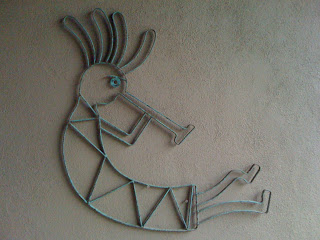
Sunday, March 7, 2010
Mystery or History?

Photographer: Spencer Porter
This metal kokopelli is hanging up on an outside wall at my house. Up until now, I had no idea what the significance of this piece was or where it originated. This is one of the most common characters from Native American cultures that is used as decorative pieces in homes all over the world. The kokopelli figure has several stories and myths related to its origin including a trickster god who represents music.
Pinned Up

Photographer: David Glassanos
This fur is used as a decoration piece in my roomate's bedroom. It has very little significance and purpose to him other than to decorate the room. To many others, though, this fur might have much more meaning. It might be used in a spiritual ceremony or worn as clothing in the winter. There might be a story or some anecdote about where the fur came from and why it is significant to their culture.
Please Touch

Photographer: Veronica Simon
"Please Touch" says a sign below this drum in the Arizona State Museum. A few people will handle it carefully to admire detail, craftsmanship, or tradition. Many more with jokingly play this drum, either pretending to be a rock star or pretending to be a "real" Native.
The Drum Display: Embodiment of tradition or entertainment.
The chips fall where they may...
Dance For Me

Photographer: Spencer Porter
This photograph is a representation of a Hopi native dance. The spiritual nature of this dance form is taken for granted and not understood by much of the population. Some people view this ritual as a performance rather than a sacred act, and take it as a joke such as the famous "rain dance."
Family Ties
Just Another Pot

Photographer: David Glassanos
This Native American pottery is located in the pottery exhibit at the Arizona State Museum on campus. I chose this pot because I wanted to show that this pot might be used as a decoration piece in someone's house or backyard. Someone might choose to place this pot in their front entry way because the colors match the paint on the walls or a leather couch in their living room.
To the people who made this pot, it could have an entirely different meaning. The intricate details of the paintings might be telling a story. It might have some important significance like the history of their culture. To the general public though, it is just another pot.
Subscribe to:
Comments (Atom)

